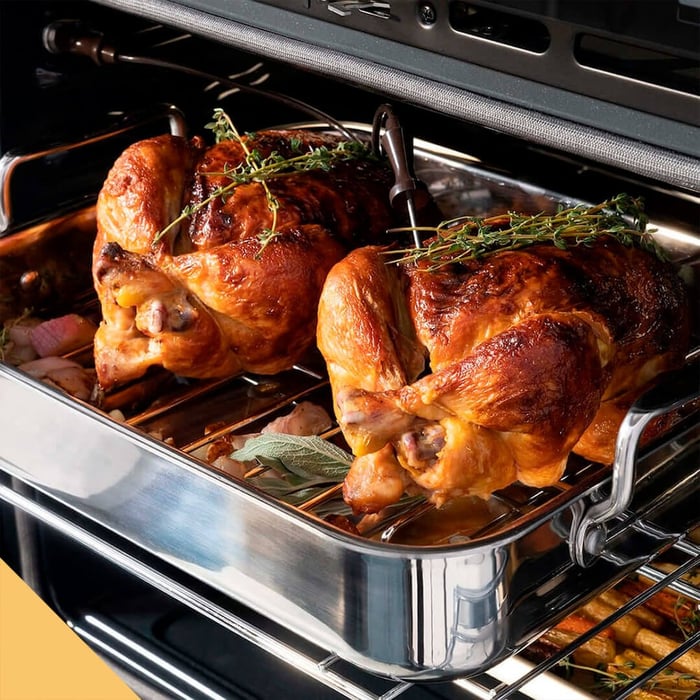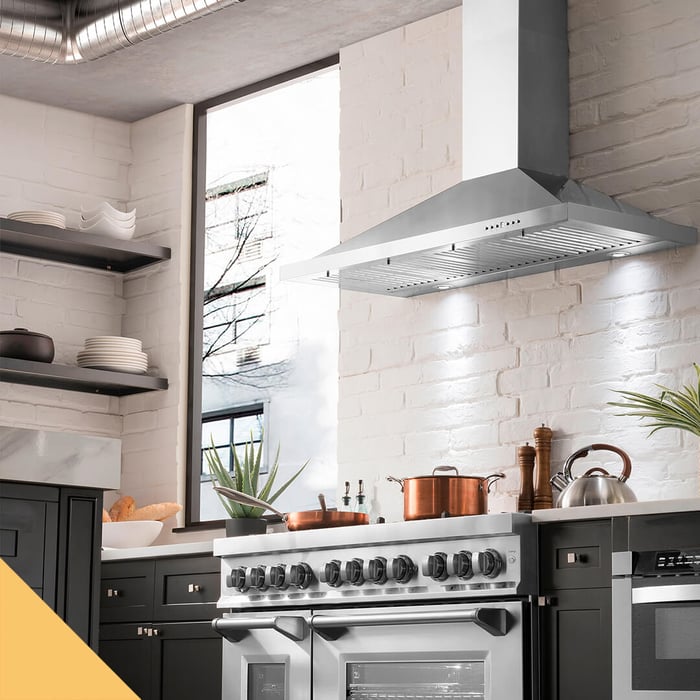Table of Contents
Over-the-range microwaves are a tried and true kitchen appliance. By combining the cooking capability of a microwave with the ventilation capability of a range hood, an over the range microwave can be both stylish and functional.
Unlike countertop microwaves, over the range microwaves are designed to be installed over a range, stove, or cooktop. Installing an over the range microwave may sound difficult at first, but this is an installation you can do with the help of a friend or household member. In this post, we’re covering how to install an over the range microwave and answering some common questions we receive at The Range Hood Store about over the range microwaves.
What is an Over the Range Microwave?
An over the range microwave is specifically designed to be mounted next to cabinets and above a cooking range, cooktop, or stove. This positioning allows it to serve as a convenient cooking appliance and a ventilation system for your kitchen.
By incorporating a built-in ventilation system with a fan and filters into its base, over the range microwaves help to remove smoke, steam, and odors that arise from cooking on the cooking surface below.
Most over the range microwaves have all the features and settings found in traditional countertop microwaves, and some models incorporate additional features like convection cooking or sensor cooking, depending on the model.
What Size Over the Range Microwave Do You Need?
To determine what size over the range microwave you need you should collect accurate measurements of the cutout above the cooking surface. Measure the width, depth, and height of the space that is available. There may also be ventilation requirements specified by the manufacturer of your cooking surface that should be accounted for. Also, take into consideration your personal style to ensure the microwave you choose will fit seamlessly into the heart of your home.
Width: Most over the range microwaves are 30 inches wide, which is also the most common width of freestanding ranges. To ensure that 30 inches is the right width, measure the width of space above your cooking surface. There are also compact over the range microwaves better suited for smaller spaces, which are usually 24 inches wide.
Height: Over the range microwaves have a standardized height of 17 inches. Measure the height from the bottom of the upper cabinets to the cooking surface of your range. There are also specialized models called low-profile over the range microwaves which can fit in spaces as low as 10 inches.
Depth: Over the range microwaves have different depths, usually ranging between 15 and 18 inches. Measure the depth from the wall to the front of your range to determine the maximum depth of the microwave that will fit comfortably in the space.
Over the range microwaves should be installed around 30 inches above the top of the cooking surface and far enough away from any perpendicular walls so that the door can fully open.
Taking accurate measurements of the available space and considering any ventilation requirements will help you determine what size over the range microwave you need.
Explore Over The Range Microwaves

How to Install an Over the Range Microwave
Tools and Materials Needed
Before starting, gather all necessary tools and materials:
Drill and bits
Measuring tape
Stud finder
Level
Screwdriver
Pencil
Mounting template (usually included with microwave)
Mounting Hardware (included with microwave)
Any other tools/materials that are specified in the model’s manual
Safety Precautions
Safety first! Ensure you:
Turn off the power to the area.
Wear safety glasses and gloves.
Have a helper for heavy lifting.
Preparation Steps
Familiarize yourself with the microwave’s installation manual.
Check for venting requirements, and determine if your microwave vents externally or recirculates air.
Remove any items from the stovetop and surrounding area.
Save yourself any headaches and test the microwave before installation.
Removing the Old Microwave
Ensure the power is off to avoid electrical hazards.
Unplug and disconnect any venting and electrical connections.
Remove the mounting hardware by unscrewing the microwave from the cabinet above, and supporting it to prevent dropping.
Remove the microwave from the mounting plate. Usually, this involves tilting the top of the microwave towards you at an angle and lifting the back of the microwave up and off of the mount.
Remove the mounting plate. If you’re installing the same brand as your previous microwave, there’s a chance your new microwave will use the same bracket. Be sure to check the included hardware, as this will save you a few steps.
Now you are ready to install the new microwave!
Installing the Mounting Plate
Use a stud finder to locate studs for secure mounting.
Tape the mounting template on the wall, ensuring it’s level and matches the corresponding holes on your template to the stud(s).
If you do not have a template, you can request a new template from the manufacturer or contact us for further assistance.
Mark the mounting spots with your pencil, ensuring at least one is on a wall stud. Then, using an appropriate-sized drill bit, drill the pilot holes for the bolts and/or wall anchors.
Remove the template; you do not want to leave the template as this can become a hazard.
Attach the mounting plate by securing it to the wall with bolts and/or wall anchors, ensuring it’s firmly in place. Do not over-tighten.
Drilling the Top Mount/Mounting Bracket Holes
Follow similar steps as the mounting plate to prep where you will attach your microwave to the cabinetry.
Position and tape the top mount template to the bottom of the cabinetry
Mark The Holes.
Remove the template.
Drill the top mount pilot holes into the cabinetry.
If the bottom of the cabinets is recessed, be sure to use appropriate-sized blocks of wood to provide a flush mounting surface for the top of the microwave.
Prepping the Microwave
Adjust the microwave’s venting configuration if necessary. Your instruction manual should have detailed instructions for each setting and how to set it up. If you are using a recirculating configuration, you should also ensure your filters are installed at this point.
Attach the mounting bracket per your manufacturer’s instructions.
Mounting the Microwave
With your helper, tilt the front/top of the microwave forward slightly, and lift the microwave to the wall mounting bracket.
Line up the hook or mounting slots and rest the rear of the microwave on the wall mounting bracket.
Thread the power cable through the previously drilled hole and take up any excess slack.
Insert the top mounting bolts through the holes previously drilled and screw each bolt by hand. Ensure the power cable isn’t caught.
Using a screwdriver or electric drill, tighten down the mounting bolts until snug. Do not over-tighten.
Venting
If venting externally, align and connect the ducting to the transition/damper outlet.
Secure with a clamp or heat-resistant duct tape.
Power and Test
Plug in the microwave.
Turn on the microwave to test functionality. Test with food or a beverage to avoid any damage to the unit.
Verify that the ventilation system is functioning correctly.
Common Installation Mistakes to Avoid
Not using a stud finder: Mounting without proper support can cause the microwave to fall.
Skipping the leveling step: An unlevel microwave can affect cooking performance.
Ignoring ventilation setup: Incorrect venting can lead to poor air circulation.
Troubleshooting Tips
If the microwave doesn’t power on, check the electrical connections and circuit breakers.
Ensure all screws and bolts are tightened securely to prevent wobbling.
Maintenance Tips for Longevity
Clean the microwave regularly to avoid buildup.
Check and replace filters as needed.
Inspect mounting hardware periodically to ensure stability.
What is the best Over the Range Microwave?
A: ZLINE’s 30 in. Over the Range Convection Microwave Oven (MWO-OTR-H-30) is one of our best-selling microwaves here at The Range Hood Store, and it’s a no-brainer as to why! It has a sleek, modern design available in stainless steel, black stainless steel, or fingerprint-resistant Satin Stainless Steel. You can further customize by selecting a modern or traditional handle to perfectly match your kitchen style.
This microwave performs just as well as it looks. With DiamondTech technology (a diamond interior that scatters microwaves for no cold spots) and its 900 watts of power, you never have to worry about a half-cooked meal again!
Some of this microwave's unique features include:
Convection Bake & Standard Microwave Modes that can be used separately or simultaneously
Stainless Steel interior and exterior for effortless cleaning and maximum heat
Illuminated and audible LCD screen for optimal access
A glass turntable to distribute heat evenly
One-Touch cook for quick and easy snacks
Control lock for added safety and peace of mind
ZLINE 30 in. Stainless Steel Over the Range Convection Microwave Oven with Traditional Handle (MWO-OTR-H-30)

$620.49
$729.99
Luxury isn't meant to be desired - it's meant to be attainable. Designed in Lake Tahoe, USA, the ZLINE 30 in. Stainless Steel Over the Range Convection Microwave Oven with Traditional Handle (MWO-OTR-H-30), and Sensor Cooking provides a professional culinary… Read More

What is a Microvisor?
A: A Microvisor is a product designed to address the issue of fumes escaping while cooking on the front burners of a range or cooktop when using an over the range microwave as an exhaust system. When a Microvisor is installed, it captures and redirects up to 90% of the total cooking byproducts to the over the range microwave’s exhaust. Additionally, the Microvisor provides a heat shield to protect the over the range microwave from the heat generated during cooking.
MICROVISOR Removable Extension Hood with Color Options (MVSB-30)

$159.99
MICROVISOR is an efficient microwave range hood extender, designed to attach to "over-the-range" microwaves to enhance the microwave's venting functionality. A great accessory add-on if you plan on using an over-the-range microwave to vent above your stovetop. The MICROVISOR Removable… Read More

In conclusion, over the range microwaves offer a versatile and efficient solution for your kitchen needs. Not only do they provide the convenience of a microwave, but they also serve as a range hood to keep your kitchen well-ventilated. When choosing an over the range microwave, it's important to consider the size that fits your space and meets your style preferences.
Installing an over the range microwave may seem daunting at first, but with the right instructions and a bit of DIY spirit, it can be a straightforward process. By following the step-by-step installation guide provided in this blog, you can successfully replace or install your own over the range microwave in no time.
Explore Over The Range Microwaves
If you would like help finding the perfect appliances for your home, book a consultation with one of our appliance experts!
Connect with us on social media!
Facebook: The Range Hood Store
Instagram: @therangehoodstore
YouTube: The Range Hood Store
Pinterest: @TheRangeHoodStore
FAQs
What is an over-the-range microwave?
An over-the-range microwave is a microwave designed to be installed above a range or cooktop. It combines microwave cooking with built-in ventilation to remove smoke, steam, and odors from your cooking surface, functioning similarly to a range hood.
Is installing an over-the-range microwave difficult?
Installation is very manageable for most homeowners with basic tools and a helper. While the unit is heavy and requires careful measuring, following the manufacturer’s instructions step by step makes the process straightforward.
How long does it take to install an over-the-range microwave?
Most installations take between one and two hours, depending on whether you are replacing an existing unit or installing a microwave for the first time.
Do I need a professional to install an over-the-range microwave?
A professional is not required, but recommended if you are uncomfortable working with electrical connections, cabinetry, or venting. Many homeowners successfully complete the installation themselves with proper preparation.
What size over-the-range microwave do I need?
Most over-the-range microwaves are 30 inches wide to match standard ranges. Compact kitchens may use 24-inch models. Height is typically 17 inches, while depth usually ranges from 15 to 18 inches. Always measure your available space before purchasing.
How high should an over-the-range microwave be installed?
Over-the-range microwaves should generally be installed about 30 inches above the cooking surface. This spacing ensures proper ventilation and safe operation.
Can over-the-range microwaves vent outside?
Yes. Many models allow for external venting through ductwork. If outside venting is not possible, most over-the-range microwaves can also be configured for recirculating ventilation using charcoal filters.
What tools are needed to install an over-the-range microwave?
Common tools include a drill, drill bits, stud finder, level, measuring tape, screwdriver, pencil, and the mounting hardware and templates provided by the manufacturer.
Do I need to locate wall studs during installation?
Yes. At least one mounting bolt should be secured into a wall stud to ensure the microwave is safely supported. Skipping this step is one of the most common installation mistakes.
What are the most common installation mistakes to avoid?
Common mistakes include not using a stud finder, failing to level the microwave, overtightening mounting bolts, and setting up the ventilation incorrectly for your kitchen layout.
Should I test the microwave before finishing installation?
Yes. Testing the microwave before final mounting can save time and frustration by ensuring the unit powers on and functions correctly.
Can I reuse the mounting bracket from my old microwave?
Sometimes. If you are replacing a microwave with the same brand and model series, the bracket may be compatible. Always verify with the manufacturer before reusing old hardware.
What is a Microvisor and do I need one?
A Microvisor is an accessory that attaches beneath an over-the-range microwave to improve ventilation capture, especially for front burners. It redirects heat, smoke, and grease toward the microwave exhaust and helps protect the microwave from excessive heat.
What is the best over-the-range microwave?
The ZLINE 30-inch Over-the-Range Convection Microwave Oven is a top recommendation. It combines microwave and convection cooking, offers multiple venting options, and features premium finishes like stainless steel, black stainless steel, and Satin Stainless Steel. Its design flexibility and reliable performance make it a standout choice.
Are ZLINE over-the-range microwaves good for DIY installation?
Yes. ZLINE microwaves are designed with clear installation instructions, included templates, and flexible venting options, making them well suited for both DIY installs and professional installation.
How do I maintain my over-the-range microwave after installation?
Clean the interior and exterior regularly, replace or clean filters as recommended, and periodically check mounting bolts and brackets to ensure the unit remains secure.
Is an over-the-range microwave a good replacement for a range hood?
For light to moderate cooking, yes. Over-the-range microwaves provide effective ventilation while saving space and reducing the need for a separate range hood, making them a practical and stylish kitchen solution.






